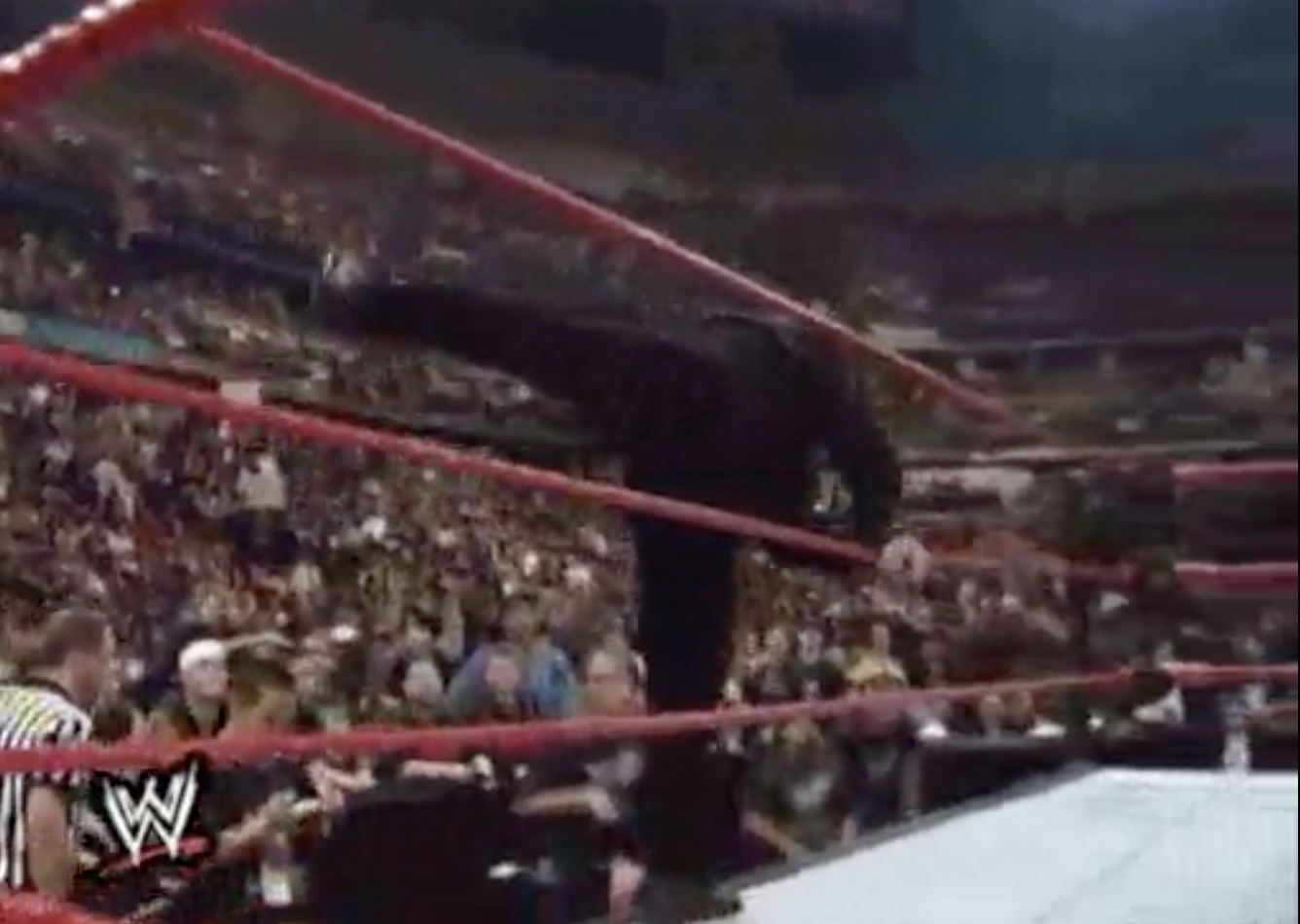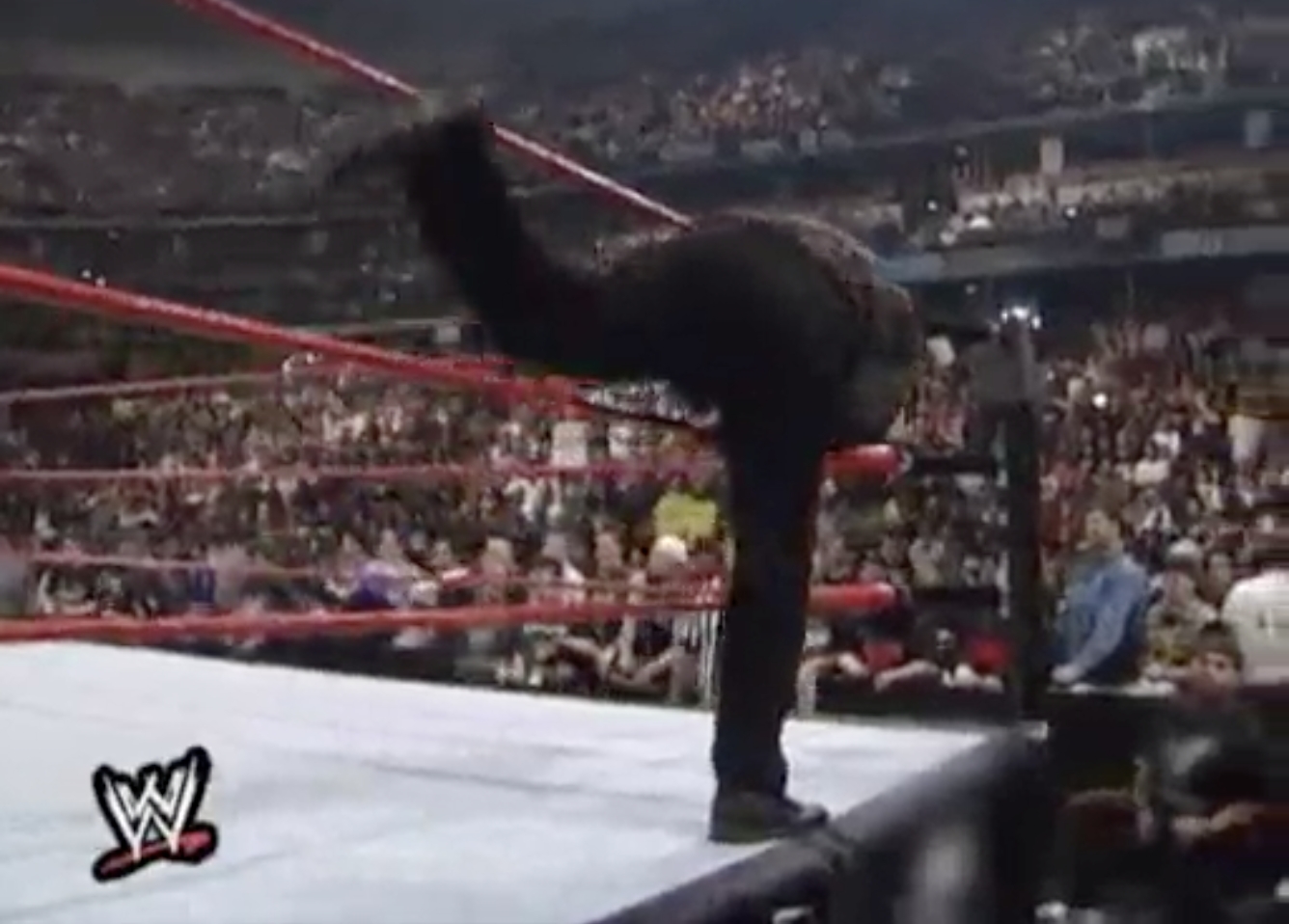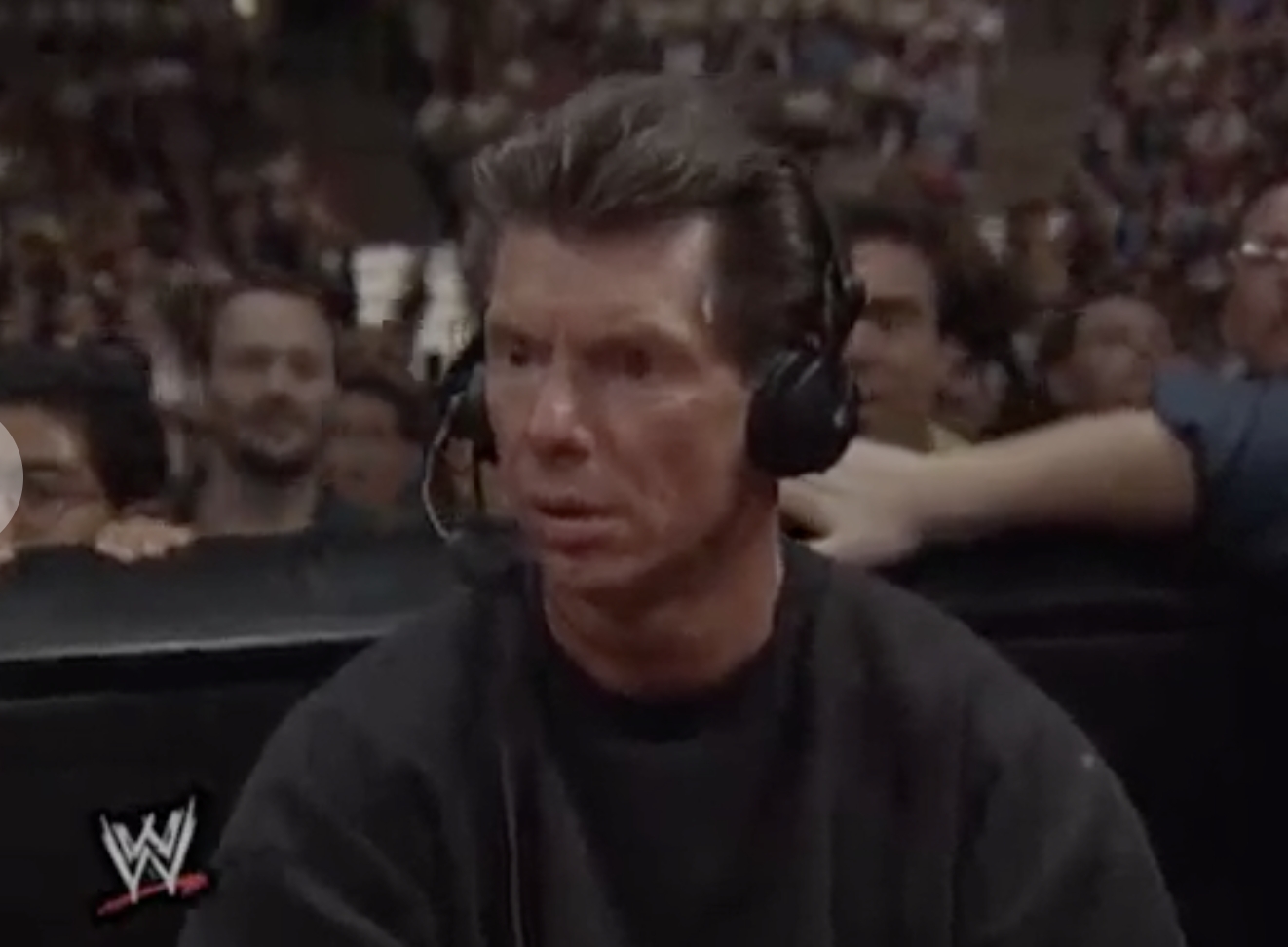The Royal Rumble is WWE’s second biggest match every year. Thirty wrestlers stream into the ring, one at a time, until only one of them has avoided being thrown over the top rope. The prize is a spot in the biggest match, the main event at WrestleMania.
Those who spend the longest time in the ring end up taking the most damage, meaning most of the event’s champions have entered the ring at No. 23 or later. It’s billed as a grueling endurance test, especially for early entrants, who must last an hour or more just to make the final two.
But here’s the thing: it’s actually very easy to win.
Seemingly every year, the announcers draw attention to the quirk of the event’s main rule: A wrestler can leave the ring and still remain eligible so long as they leave under the top rope. Usually, as soon as an announcer points this out, someone will be knocked through the middle of the ropes, do something cool, and come back in. That’s usually the end of that.
What I am urging you to do, wrestling villains, is to actually capitalize on this dumb rule.
When one plays a wrestling video game, one can’t help but note that the surest Royal Rumble strategy is to avoid conflict. Stand in a corner, do taunts, and let everyone else beat each other up. Only fight when you have to. Reach the end with more health than the other finalist, and essentially win a one-on-one match instead of a one-on-29 match.
But for some reason, entering the Royal Rumble makes all wrestlers become bloodlusted berserkers. Each new entrant charges into the ring, meddles in all of the ring’s ongoing engagements, and becomes as big a target for elimination as possible. Announcers sometimes complain about opponents preventing each other from eliminating common enemies, but it happens anyway, several times every year.
The way to increase your odds of winning the Royal Rumble is to get in as few fights as possible while you’re in there. If no one is fighting you, no one can throw you out.
It is completely legal, per the rules of the match, take this to the extreme. Roll under a rope, flee until any pursuers become entangled in new disputes, hide somewhere, and jump back in after the last contender is gone. Every year, to watch the Royal Rumble is to wonder why nobody is trying this.
What’s even more frustrating is that there is precedent for this plan, and one time, it worked far better than the perpetrator ever intended.
In 1999, toward the end of the legendary feud between Stone Cold Steve Austin and Vince McMahon, the two wound up entering the Royal Rumble at No. 1 and No. 2. Both made it clear that their rivalry mattered more than winning the Rumble. Austin wanted to punish the company’s tyrannical CEO, while McMahon just wanted two-time reigning champ Austin to lose, even putting a $100,000 bounty on Austin’s elimination.
Before the opening bell rang, ring announcer Howard Finkel explained and re-explained the “over the top rope” rule, telegraphing the inbound mockery of said rule.
Austin had a chance to eliminate McMahon with ease early in the Rumble, but preferred beating up his boss over not beating up his boss. Entrant No. 3, some guy I’m not sure I’ve ever heard of otherwise, distracted Austin, and McMahon fled under the ropes to the arena’s concourse. Austin rolled under the ropes in pursuit, and McMahon goons ambushed Austin, beating him until he had to be carried to an ambulance.
Oh right, the Rumble itself. The production returned its attention to the ring, where little had been planned, other than the overwhelming Austin-McMahon storyline. There ensued a C plot about the Undertaker’s cult kidnapping Mabel (the lights went out during Mabel’s exit, so there is no indisputable visual evidence Mabel was ever eliminated), but since the entire hour-long event was built around a story that’d literally left the building, the middle was shockingly boring and low on star power.
“Nearly a quarter of the participants wouldn’t make it into that summer’s WWF Attitude, a game that included Head as a playable character. Most of the Rumble match could be re-created by a seven-year-old whose mom only bought him the cheap action figures left on the Toys ‘R’ Us shelf (and having grown up with three Giant Gonzalez dolls, I know what I’m talking about). Frankly, besides Austin and McMahon, the only two men in the Rumble with even the remotest chance of winning were Kane (whose one-day WWF title reign made him the only other former world champ in the match) and Triple H (who at that point was maybe the 5th-most over member of D-X)[Okay, I exaggerate, but most of the other DX members got louder pops during their entrances on this night].”
Every few minutes, neutral commentator Michael Cole wondered about McMahon’s whereabouts, only to be shushed by the complicit villain apologist Jerry Lawler.
McMahon still influenced proceedings from afar, and not just because he actually owned the ring and was literally in charge of the entire pay-per-view event’s script. His character managed to get rid of viable threat Kane, the Rumble’s annual biggest ring-clearer, by [problematic 1999 vibes] sending “insane asylum” orderlies until Kane fled the ring over the top rope, eliminating himself because very tall wrestlers have never figured out how to enter or exit a ring without stepping over all the ropes.
It wasn’t until Kane cleared the ring of wrestlers, including himself, that McMahon returned, nearly 26 minutes after he’d fled under the bottom rope. Half of the non-Austin/non-McMahon field had since been eliminated. Here he is, confirming he still considered himself eligible:

McMahon ally Ken Shamrock then entered the ring opposite McMahon, and so…

…McMahon returned to the job he’d held before he became a meddling despot who gets pummeled by Stone Cold Steve Austin: wearing a headset (which he IRL owns) at the commentary table (which he IRL owns) next to Cole (whom McMahon also IRL owns), claiming all the day’s tasks had been accomplished, since the injured Austin wouldn’t win. As Cole and Lawler continued to remind the viewer McMahon was still in the match, McMahon insisted he had no interest in rejoining the fight.
The plan hit a snag when Austin returned to the arena, driving his own ambulance. An all-time meme face legend went to work.

Austin chased McMahon around the ring, but the villain managed to lead Austin through traffic within it, ensuring a safe return to the announcers table, Austin taking more damage, and Austin eliminating more wrestlers. Another effective piece of character work: despite having a headset, McMahon did not slip back into the commentator mode of his previous three decades. His remarks focused on Austin and who could eliminate him.
Austin seemingly became dumb again, doing very normal wrestling against Triple H and X-Pac and everyone else, forgetting about the guy at ringside who’d sent him toward the hospital during this very hour. But it really wouldn’t have made sense to pursue McMahon until the elimination of Big Boss Man, another McMahon ally. And Austin showed he hadn’t forgotten about McMahon by leaving the ring to dump water in McMahon’s face.
(You know the other really dumb thing wrestlers do during Royal Rumbles? When they prevent an opponent from eliminating another opponent, for no reason other than sheer desire to hit somebody? In this match, the $100,000 bounty on Austin provided an explanation for once. When Triple H prevented two guys from throwing out Austin, it made sense. Triple H wanted the bounty for himself.)
Finally, Austin eliminated Big Boss Man, then left the ring to drag McMahon in. Once again, Austin declined to eliminate his rival, instead gloating and … yelling at materialized distraction The Rock, yet another McMahon ally at the time. Oh hey, it’s The Rock. (Earlier in the night, he’d had a heated gamer moment and beaten Mick Foley with a chair for real.)
The story told by the first 56 minutes and 30 seconds of the match was that Stone Cold and Vince McMahon cared about beating each other more than anything else in the world, and that none of the 28 other contenders mattered (most of them have been largely forgotten to history or resembled rejected Adam Sandler characters, so this is partially fair). Austin wanted to brutalize McMahon more than Austin wanted to win. McMahon wanted Austin to lose more than McMahon wanted his own money.
And then, at the very end, Austin cared about yelling at The Rock more than he cared about any of this. Sure!
McMahon won the 1999 Royal Rumble by running, hiding, and sitting around for almost an hour, dealing almost literally no offense. A few pathetic slaps, that one hoist at the end, and there you have it: the greatest Royal Rumble strategy of all time, even if it only arose by accident after Austin’s surprise return to the ring.
It started and ended as a one-on-one match, with 50 minutes of useless filler in between. McMahon didn’t even keep the match’s prize, forfeiting his WWF title shot. Austin-McMahon had to happen as many times as possible, but there was no reason for it to happen in a Royal Rumble. Its only payoff was highlighting how easy it is for a supervillain to exploit the event’s dumb rules.
Were lessons learned? Did bad guys attempt this same strategy in the 2000 Rumble? Nah, The Rock won by doing normal wrestling stuff.
Every year, somebody loiters right next to the ring, gets forgotten about while selling an injury, or is a comedy wrestler just doing a version of the Coward’s Gambit for comic relief. And every year, Kofi Kingston deploys physical genius to re-enter the ring after being thrown out, hacking the event’s other rule: two feet must touch the floor. But totally vacating the premises on purpose? This remains a massive opportunity for the motivated coward.
Lawler, the McMahon apologist, had actually attempted a version of this in 1996, hiding under the ring for 36 minutes until fans reported the crime to Shawn Michaels. The subservient bootlicker Lawler failed because he only attempted a pathetic version of the Coward’s Gambit. He merely left the ring itself, when he should’ve left the floor, the arena, the neighborhood, only returning to the ring when the coast was absolutely clear.
The 1999 Royal Rumble is widely considered one of the event’s worst iterations ever, but not necessarily because of the goofy finish. Those happen all the time. And not entirely because the boss booked himself to win — he was the company’s greatest heel, and he won in the most heelish manner possible, and it’s not like he booked himself to actually win the title belt itself (until a few months later, when he rigged a far more contrived story, but that’s a whole other thing). The main problem was that two wrestlers completely overshadowed 28 others.
However, there’s absolutely a way to use the Royal Rumble’s stupid rule to tell not just one fitting story, but a multi-year story.
It’s a mystery why the company didn’t fix this rule, once it’d been fully exposed in 1999. The company’s CEO was the one who hacked the rule, but wouldn’t he want to prevent anybody else from besting his own target-of-opportunity winning strategy?
But the even bigger mystery is why all the bad guys don’t deploy this chicanery every year. It makes sense that the rule-following John Cenas sprint into the ring to deliver hardo justice, but the diabolical Seth Rollinses should don ghillie suits beneath the popcorn stands.
So here’s what we’re gonna do. We’re gonna take over the book and establish control of WWE’s scripts. Then we’ll have a villain go full McMahon by deploying the Coward’s Gambit not just as a means of embarrassing one opponent, but specifically and intentionally as a means of winning the match. We’re gonna have this villain win the belt at WrestleMania and parade this newly minted monster heel as a genius.
Will we then fix the rule, perhaps by requiring devious under-ropers to get back into the ring within 10 seconds? No. Not yet. We will not surrender content that easily.
At the following year’s Rumble, an impossible to ignore number of bad guys will attempt the same scheme. Eventually, the viewer will realize there are 15 villains running laps around the ring, all of them too dastardly to work together in any way, each of them trying to throw their fellow scumbags into the ring so that the justice hardos can then throw them out for good. We’ve just created a MultiRumble, a Disloyal Rumble encircling the Royal Rumble itself, bad guys chasing bad guys in a NASCAR orbit around good guys chasing good guys, wheels within wheels as the prophet Ezekiel witnessed in the heavens.
And then, the year after that, we fix the rules and promise the viewer the most honest Royal Rumble of all time, straight down the middle. We then let someone win via some totally different bullshit, and voila: several years of highly memorable Rumbles, all thanks to one stupid rule.







